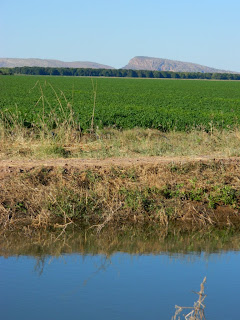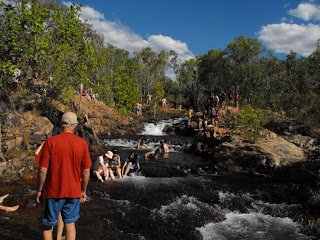Well it has been quite a while since we logged an entry in our travel blog so if you have been checking without success we sincerely apologise.
A great deal has been happening though so we have a lot of ground to cover in bringing you up to date. In our last entry we advised that we were heading back to SEQ to see our family and for us that was a wonderful time. We were blessed greatly in that Merv & Joie Westbrook who are pastors at COC in Darwin and long time friends with Alice offered for us to leave our car & van on the church property at Berrinba not far from the airport. This was just wonderful for us and Joie graciously dropped us off at the airport for our mid night flight back to Qld. Isn’t it great to have wonderful friends.
The COC Church in Darwin is an amazing operation. Even though they are not large in number they operate quite a large hostel for mostly indigenous people who have to travel to Darwin for medical care or other special reasons. There are people coming in and out continually and it is quite a busy place. They also have a large interest in overseas missions and financially support over 5000 pastors in many countries in Africa, Asia, Philippines, Indonesia and others. A lot of the funding for this support is generated by businesses that they have established for just this purpose including a farm and a retail furniture business. The church is the closest example of a community that I have ever seen. They are a very effective operation. On return we were able to spend time with them in church and enjoy a Fellowship Tea also.
Back in Queensland we were able to spend time with Ian’s father through a few visits as well as time with each of our family with the exception of Joy & Luke in Chinchilla. Unfortunately & disappointingly it was not possible to make it out there. However the time we spent with those who we could meet was just so wonderful. We had been really missing them so this quality time, particularly with our grandchildren was very special.
All good things must come to an end however and we made our way back to Darwin on the 15th of July. Apart from the necessary time needed to restock and complete some van repairs (it is showing its age) we were able to see some more of Darwin. In particular we did enjoy some time at Casuarina Reserve which is a beach area to the north edge of Darwin. Here the beach is edged by some spectacular, though not too high stone cliffs.
 |
| The cliffs of East Point Darwin |
 |
| Darwin CBD from East Point |
Ian also spent some time visiting the Aviation Museum where there were some interesting aircraft on display. The pride of the museum is the large B52 bomber. It totally filled the hanger building and all other aircraft sat under her wings. She really did look like mother hen. Some may not know that the B52 has not been long retired from the US Air force but is probably best known for long range bombing raids into Vietnam during the war there. It is powered by six jet engines. Coincidently the US Air force is here with the Australians and playing war games so each morning the F18s noisily take off from Darwin airport across the city. I understand that they are linking up with exercises in Central Queensland. Shows how small the world is.
 |
| B52 Bomber fills the hanger |
 |
| Aus Mirage fighter - retired but still looking up to date |
On Tuesday 19th we left Darwin heading for West Australia. Our first intended stop was to be Edith Falls some 60 klms north of Katherine however on arrival we found the “Full House” signs out. We had been amazed all day with the number of caravans heading north to Darwin and we were to find out soon after that this was just to be the start. The flood gates have certainly opened and it is getting very difficult to find accommodation. Even the few free stops along the road are full and some are choosing to pull up anywhere they can, legal or not.
Edith falls is part of Nitmiluk National Park which includes Katherine Gorge as it main feature. The falls are more like cascades and while they are beautiful visually they are more appreciated by visitors as a cooling off swimming opportunity. Seeing that it is still school holidays here the camp ground was really full and no one was rushing to move out either.
 |
| Edith Falls |
 |
| More a holiday camp than a visitors view |
We spent the night in Katherine and then on again next morning. The road west to the border is again quite flat. The country is quite similar to what we have seen right through NT but as we drew closer to Victoria River Roadhouse (approx 200klms) the road followed a path leading between some tall red rock ranges. These were quite spectacular. Then we dropped down to cross the Victoria River and the roadhouse, located on the western bank looked like an emerald green oasis in a red dirt landscape. There are only two fuel stops in over 500 klms from Katherine to Kununurra and this was the first so there were a lot of travellers stopped to refuel vehicles and occupants.
The Victoria River is the largest river in the Northern Territory and the road runs quite close to it (although not always in sight) from Victoria River Roadhouse to a point west of Timber Creek. Because we were unsure of where we could stop that night and we had still a way to go we did not spend a lot of time here. The roadhouse we had heard from past years was not a great stop but the signs said “Under New Managers Wife” and there were beautiful green lawns, great camping areas and good facilities on offer. The wife must know how to pull some strings.
 |
| Crossing the Victoria River near the roadhouse |
On further we travelled and arrived at Timber Creek about lunch time. This is the other fuel stop and here we actually found it was a little more than a roadhouse. Here we booked into a small park which was quite cheap and after checking it out quickly extended our booking for a second night. This is a very relaxing stop and plenty to see.
Coming into Timber Creek we saw our first Boab tree. Apart from a transplant in Perth Botanical Gardens we have only seen photos of these amazing trees but here is their real home. We are yet to learn all about these trees but the first thing we learnt was that they can heal themselves when scarred in any way. In two places in WA they were hollowed out as early jails and they healed over the new carved surfaces.
 |
| The Boab tree is a feature of the Kimberleys |
We took a sunset cruise down the Victoria River. We were picked up at our camp in an old 1971 bus similar to school buses we remember. We then received a commentary of the history of Timber Creek as we travelled out to the boat approx 10 klms. Timber Creek received it’s name from the explorer / surveyor Gregory who had holed his boat at the mouth of the Victoria River and set out looking for suitable repair material. In small tributary he found paper bark trees which he chose for his repair. Therefore he called it Timber Creek. The story goes on in depth but he soon found out that paper bark was not a good repair material. The National Park surrounding the town is called Gregory National Park. We boarded the boat in Big Horse Creek. We were told that large Barramundi are often called “big Horse” and they catch a few there. Then we set out down the Victoria River at great speed. The river was quite wide and they experience eight metre tides at the mouth so it varies in depth quite significantly. We saw some crocs both freshwater & salties, small rock wallabys and lots of birds. The banks were very green, more than we have been seeing lately. Some 25 klms down stream we came to a pontoon where we stopped for refreshments. The skipped threw a line over the side and soon a catfish was caught. He then placed it on the frame of the pontoon and called in a large Sea Eagle who swooped right onto the pontoon to take the catch. Then it was back up the river and as the sunset we had the chance of seeing the changing colours over the distant ranges and the river. Quite an experience!
 |
| Victoria River at Timber Creek |
 |
| Birdlife from the river |
 |
| Taking a rest in the park! |
 |
| And not another human in miles (except on the boat) |
 |
| A sea eagle taking a fish off the pontoon |
Next day we explored the Gregory National Park and visited a Limestone Gorge. We travelled about 60 klms down a dirt road and disappointingly we discovered when we got there that most of the gorge was closed. We did however see a unique Calcite Flow. This was a vivid white staining of a dried up water fall where the water has had a chemical reaction with the dolomite rock leaving a white limey crust or stain. It looked like snow from the distance. The geology of the whole gorge area was quite interesting. Nearby were small ponds formed by a dense cement time material which they called Tuffa.
 |
Tuffa Ponds with a Croodile tree in foreground.
Can you see why it is called Crocodile tree? |
 |
| A Caltite Flow over a water fall which is dry at the time. |
 |
| The dolomite rock of the area is weathered in a unique form. |
Back in the town we checked out the local lookouts and obtained some great views of the river. There were caravans parked in every available spot legal or illegal and we found the latter very dishonouring for the locals.
Timber Creek was only planned as an overnight stop but has been a pleasant & restful layover. As almost always the people we have met here are so interesting. On the road there are no levels of status or barriers between people and backgrounds or employment history are seldom discussed. It is all about what we have seen or where we are going, and of course the grandkids.
Caravaners on the road can be likened to people who have alziemers. We meet new friends everyday.
Tomorrow we are heading over the border and into our sixth state / territory. We are really looking forward to that














































